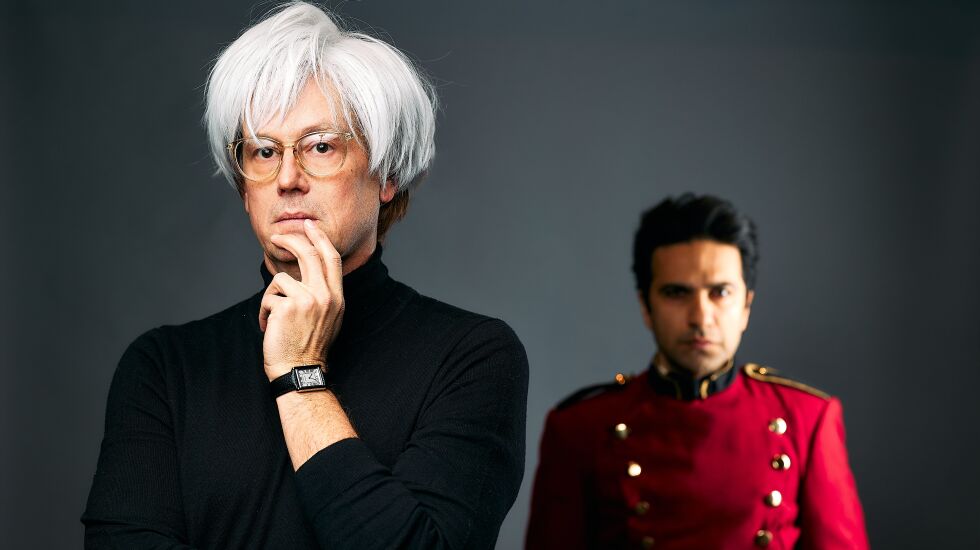
Tomato soup cans. Coca-Cola bottles. Neon-bright portraits of Marilyn Monroe, Mao Zedong and Richard Nixon. In a career spanning the early 1950s through his death in 1987, artist Andy Warhol made the mundane iconic and the iconic surreal.
But it wasn’t Warhol’s celebrated pop-art images that intrigued Maine-based playwright Brent Askari. It was instead Warhol’s affinity for dictators — specifically the artist’s 1976 visit to Tehran as the guest of the late Shah Reza Pahlavi, an authoritarian ruler who imprisoned and tortured critics of his regime.
“My dad’s a Shiite Muslim who came here from Iran to study in the 1960s, my mom’s a New England Episcopalian WASP, for lack of a better word. A lot of my work deals with those cultures intersecting,” said Askari, whose 80-minute, geo-political thriller “Andy Warhol in Iran” opens in previews Jan. 19 at Skokie’s Northlight Theater. Artistic director BJ Jones helms the award-winning drama, which premiered in June at Massachusetts’ Barrington Stage Company, winning the 2022 Berkshire Theater Award for best new play.
“The problem was that the Shah meeting didn’t work as a play,” Askari continued. “Andy was invited to Tehran to take Polaroids of [his wife], the empress [Farah Pahlavi], so he could do her portrait. But Andy’s actual time with the Shah, from everything I could find, was uneventful. There was no drama, no conflict. No arc.”
So Askari erased the Shah and the Empress from his cast of characters. Instead, he created a fictional confrontation between Andy (Rob Lindley) and Farhad, a young revolutionary (Hamid Dehghani). The men begin starkly at odds. Farhad is part of a plan to kidnap the world-famous artist, then leveraging the publicity to steer a global spotlight toward the Shah’s human rights abuses.
“Warhol was completely apolitical,” Askari said. “He was like, ‘politics is beyond me. I don’t get it. It’s abstract. These are just paintings.’ ”
In the play, Farhad vehemently disagrees, insisting that the two are not talking about politics as abstractions but as basic human rights.
Throughout the play’s dialogue, Askari weaves in the historical context leading up to Warhol’s 1976 trip: A U.S./British-backed coup in 1953 brought the Shah to power, ousting Iran’s democratically elected prime minister, Mohammad Mosaddegh. Iranian history and Warholian pop-art totems flicker within the Tehran Hilton where Askari sets the entire drama.
As Farhad, Dehghani makes his Northlight debut after a decade working in his native Iran, primarily in Tehran. He came to the U.S. in 2018 to study directing at Northwestern, where he earned an MFA last year.
“It was a personal decision for my wife and I to leave Iran,” Dehghani said. “It’s difficult to produce theater in Iran, because of the censors, for one thing. So like many young, educated Iranians, we made the difficult decision to leave.
“Farhad is similar to myself in some ways — he was raised in Iran, studied literature in the U.S.,” he continued. “But instead of using art, Farhad is drawn to something that he sees as a more immediate, more practical way of changing things. He decides to draw attention to what is happening in Iran — the torture, the oppression, the repression — all the things Andy says are ‘just politics’ — in a way that won’t be denied. He wants to use Andy’s fame to make people see what’s happening in Iran.”
As Warhol, Lindley is charged with portraying one of pop culture’s most indelibly recognizable figures (complete with a bespoke wig crafted by Natalia Castilla).
“I don’t have to impersonate Andy Warhol — nobody could. He had so many contradictions, so many sides, that’s kind of the escape clause,” Lindley said. “He let people see what only he wanted them to see. He curated his persona the way he curated his art.
“His dismissiveness of politics — I can relate to that, sort of,” Lindley continued. “I’ve had days where I’m like, I’m just an artist. But as an artist and a queer man, I’m making a political statement when I leave the house every day. I can’t ignore that reality. And as a queer man and an artist himself, Andy didn’t either.”
For Dehghani, 1976 reverberates today.
“There are differences, of course, but there are similarities between what was happening in 1976 and now,” Dehghani said. “Military dictator in power. Secret police who kill and torture anyone who criticizes the government. Women stripped of rights. Doctors, celebrities in line for execution just for making a comment.
“Anything I can do that could help raise awareness about Iran and make people more aware of our history, that is art I want to do,” he said.







